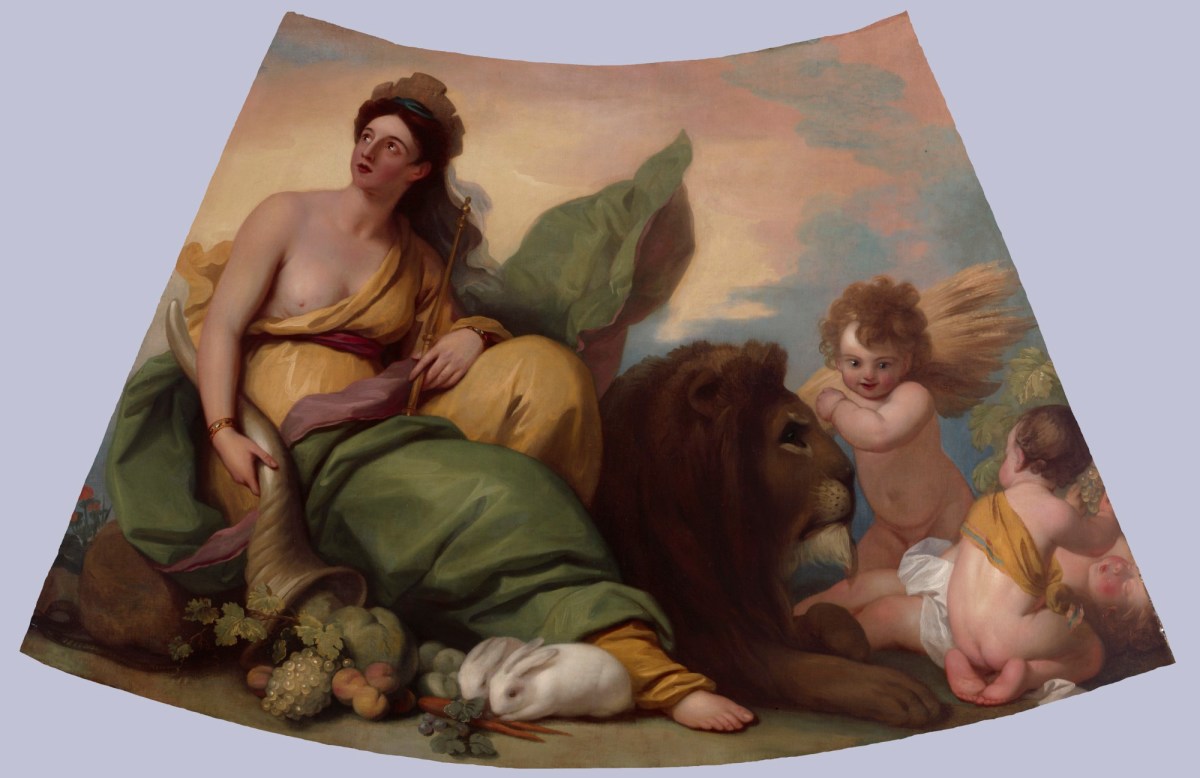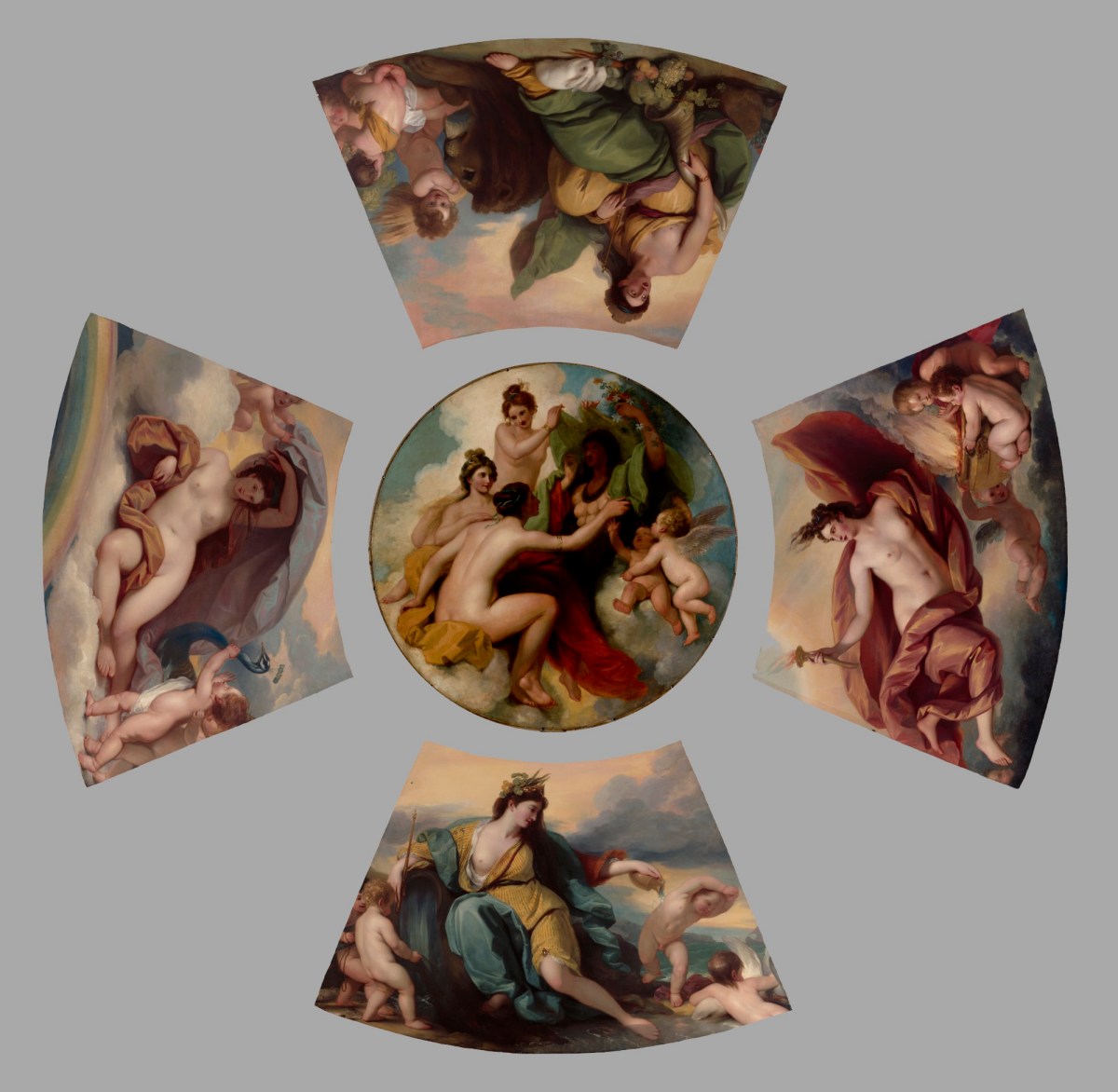
Benjamin West PRA, Earth, ca. 1779.
Oil on canvas. 1093 mm x 1854 mm. © Photo: Royal Academy of Arts, London. Photographer: John Hammond.
This image is not available to download. To licence this image for commercial purposes, contact our Picture Library at picturelibrary@royalacademy.org.uk

Benjamin West PRA, The Graces unveiling Nature, ca. 1779.
Oil on canvas. 1524 mm. © Photo: Royal Academy of Arts, London.
This image is not available to download. To licence this image for commercial purposes, contact our Picture Library at picturelibrary@royalacademy.org.uk
Earth, ca. 1779
Studio of Benjamin West PRA (1738 - 1820)
RA Collection: Art
On free display in Front Hall
This female personification of Earth gazes up as she leans on a lion. She holds a cornucopia full of produce being eaten by two rabbits. Three putti play at the right.
Benjamin West created four personifications of the Elements as a single scheme. Earth, Air, Fire and Water are known as the classical elements as the ancient Greeks believed all matter was made up of these substances: a notion that has left a legacy in western culture.
In classical art the Elements were sometimes represented as gods. Cybele represents Earth who wears a crown and is associated with the lion, as in West’s representation. The peacock in West’s Air is the symbol of Juno who at times personifies Air. Neptune symbolises Water and either Vulcan or Jupiter represent Fire. West does not seem to have adopted this symbolism for Water or Fire, particularly as these are male gods.
Although these paintings were commissioned from Benjamin West, they may have been painted by Gilbert Stuart who worked in West’s studio from 1777 to 1782. The paintings were commissioned for the Royal Academy’s Council chamber in the institution’s first purpose-built home in Somerset House. They were in the centre of the scheme with four paintings by Angelica Kauffman at the ends of the room representing the Elements of Art: Invention (03/1128), Composition (03/1131), Colour (03/1130) and Design (03/1129). Kauffman was paid £100 for her four paintings and West £125 for his five. While Kauffman represents active female figures, West’s are passive. 12 portraits by Biagio Rebecca surrounded the scheme, but these are now lost.
When the Royal Academy left Somerset House in 1837 to a shared building with the National Gallery in Trafalgar Square, the ceiling paintings were transferred. While documents in the Royal Academy’s archive indicate the paintings were displayed in the Council room in Trafalgar Square, as they had been at Somerset House (Council minutes XX, 1899, p.431 and GA minutes, 1899, pp.57-58), Hutchison writes that West’s were in the Council room but Kauffman’s were in the library (Hutchison, 1986, p.88). A drawing in the National Archives from 1832 of the design for the Council Room at Trafalgar Square shows space allocated for the West and Kauffman paintings (WORKS 33/939). However, as the drawing dates from before the Royal Academy moved, it is unclear whether this scheme was used.
The ceiling paintings were later transferred to the ceiling of the entrance hall for the Royal Academy at Burlington House in a design by T.G. Jackson. The proposal to hang them there was included in the General Assembly minutes on 20 July 1899, 32 years after the Royal Academy had moved to Burlington House. They wrote “since the removal of the academy to Burlington House [the paintings] had been lying unused in the basement, it became a question whether something might not be done to further improve the somewhat mean aspect of the Hall” (GA minutes, 1899, pp.57-58).
Object details
1093 mm x 1854 mm
Associated works of art
4 results
Start exploring the RA Collection
- Explore art works, paint-smeared palettes, scribbled letters and more...
- Artists and architects have run the RA for 250 years.
Our Collection is a record of them.







